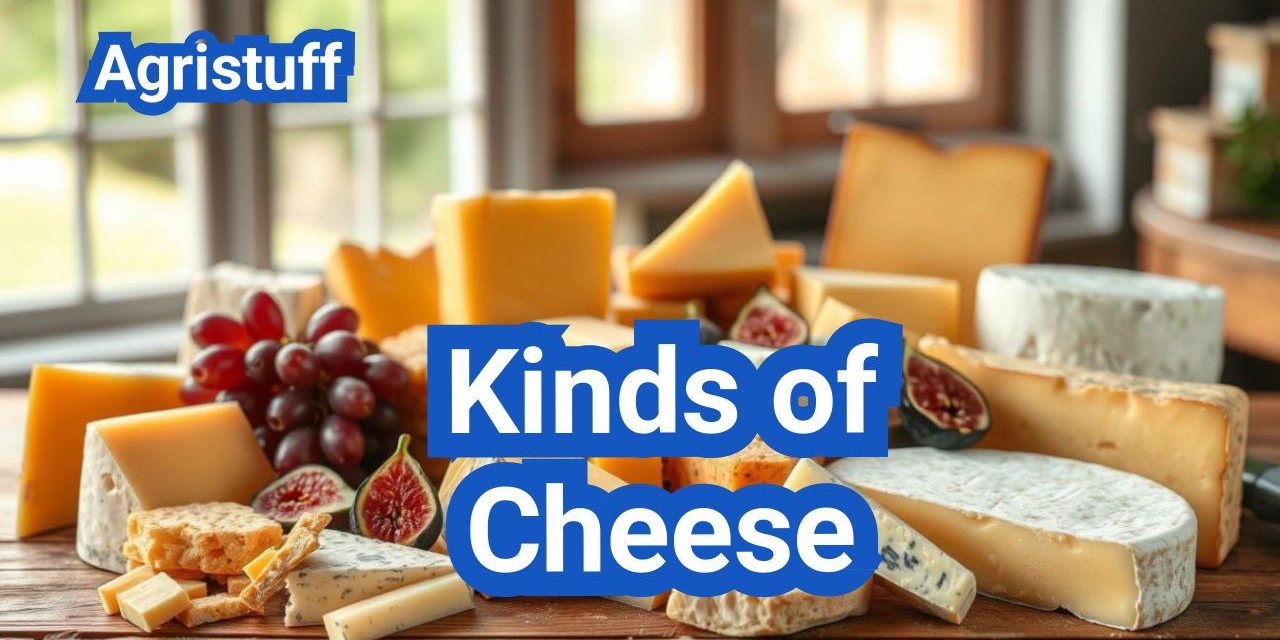The world of cheese varieties is vast and diverse, offering a multitude of styles, textures, and flavors to explore. From the creamy textures of brie to the sharp tang of parmesan, types of cheese cater to a wide range of tastes and culinary applications.
Whether you’re a culinary novice or an experienced chef, understanding the different cheese guide categories can elevate your cooking and enhance your appreciation for this beloved dairy product. With so many options available, navigating the world of cheese can be daunting, but with the right guidance, you can unlock its full potential.
Key Takeaways
- Discover the diverse world of cheese varieties and their unique characteristics.
- Learn about the different styles, textures, and flavors of cheese.
- Understand how to incorporate various types of cheese into your cooking.
- Explore the uses of cheese in different culinary applications.
- Gain a deeper appreciation for the art of cheese-making.
The World of Cheese: Understanding the Basics
Understanding cheese begins with grasping the fundamentals of its production. Cheese making is an ancient craft that involves transforming milk into a diverse array of products, each with its unique flavor, texture, and aroma.
What Makes Cheese, Cheese?
Cheese is essentially made from the proteins and fats in milk, typically from cows, goats, or sheep. The process involves curdling milk, separating it into solid curds and liquid whey, and then shaping and aging the curds. The type of milk used, the cheesemaking process, and the aging conditions all contribute to the final characteristics of the cheese.
The Cheesemaking Process
The cheesemaking process starts with milk preparation, where the milk is pasteurized or left raw, and then inoculated with starter cultures to convert its lactose into lactic acid. Rennet, a complex of enzymes, is added to coagulate the milk, forming a gel-like substance. The coagulum is then cut into pieces to release whey, and the mixture is cooked and stirred until the desired consistency is achieved. The curds are then separated from the whey, molded, and aged. The aging process can range from a few weeks to several years, during which the cheese develops its characteristic flavor and texture.
Milk Sources and Their Impact on Flavor
The source of milk is a critical factor in determining the flavor and quality of cheese. Cow’s milk is the most commonly used, producing a wide range of cheeses from mild to strong. Goat’s milk cheeses are known for their tangy flavor, while sheep’s milk produces rich, creamy cheeses. The diet of the animal, the breed, and the farming practices also influence the final flavor profile of the cheese. For instance, cheeses made from the milk of grass-fed cows can have a more pronounced flavor compared to those from grain-fed cows.
Popular Kinds of Cheese Around the World

The globe is dotted with an incredible range of cheeses, each with its unique characteristics. From well-known varieties to regional specialties and emerging artisanal cheeses, the diversity is staggering.
Most Common Cheese Varieties
Some cheeses have gained worldwide recognition for their flavor and versatility. Cheddar, for instance, is a staple in many cuisines, appreciated for its sharpness and melting properties. Mozzarella is another favorite, particularly among pizza enthusiasts, due to its creamy texture when melted.
Other popular varieties include Gouda, known for its nutty flavor, and Feta, a salty, crumbly cheese often used in Greek cuisine. These cheeses are not only enjoyed on their own but are also integral to various recipes.
Regional Specialties
Different regions around the world are known for their unique cheese-making traditions. In Europe, countries like France and Italy are renowned for their rich variety of cheeses. Brie and Camembert are French cheeses celebrated for their soft, creamy textures and white rinds.
In Italy, Parmesan is a hard, aged cheese often grated over pasta dishes, while Gorgonzola is a blue cheese with a distinctive tang. These regional specialties not only reflect local tastes but also contribute to the global cheese landscape.
| Region | Notable Cheese | Description |
|---|---|---|
| France | Brie | Soft, creamy texture with a white rind |
| Italy | Parmesan | Hard, aged cheese often grated over pasta |
| Greece | Feta | Salty, crumbly cheese used in salads and pastries |
Emerging Artisanal Cheeses
In recent years, there has been a surge in artisanal cheese production, with many small-scale producers experimenting with new flavors and techniques. These emerging cheeses often blend traditional methods with modern twists, resulting in unique products.
Artisanal cheeses can be found in specialty stores and farmers’ markets, offering consumers a chance to explore beyond the usual supermarket varieties. This trend not only supports local economies but also enriches the global cheese culture.
Classifying Cheese by Texture and Age
Texture and age are fundamental in categorizing the vast array of cheeses available to consumers today. These characteristics not only influence the taste and usability of cheese in various dishes but also play a significant role in its overall classification.
Soft vs. Hard Cheese Characteristics
The texture of cheese is one of its most defining features, ranging from soft and creamy to hard and granular. Soft cheeses, such as Brie and Camembert, are characterized by their high moisture content and spreadable texture. On the other hand, hard cheeses like Parmesan and Cheddar are known for their dense, often granular texture and lower moisture content.
Soft Cheeses: Typically have a higher moisture content, are often younger, and can be more prone to spoilage. They are ideal for spreading on crackers or bread.
Hard Cheeses: Have a lower moisture content, are often aged longer, and are excellent for grating or slicing thinly.
| Cheese Type | Texture | Moisture Content | Typical Use |
|---|---|---|---|
| Brie | Soft | High | Spreading |
| Parmesan | Hard | Low | Grating |
| Cheddar | Hard | Medium-Low | Slicing, Grating |
Fresh vs. Aged: How Time Transforms Cheese
The age of cheese significantly impacts its flavor, texture, and overall character. Fresh cheeses, such as Ricotta and Cottage Cheese, are mild and soft, having not undergone a lengthy aging process. Aged cheeses, like Gouda and Blue Cheese, develop stronger, more complex flavors over time.
“The aging process can transform a mild, soft cheese into a robust, complex delight, enhancing its texture and deepening its flavor profile.”
Fresh Cheeses: Mild flavor, soft texture, and often used in desserts or as a topping.
Aged Cheeses: Stronger, more complex flavors, varied textures, and often used to add depth to dishes.
Understanding Cheese Moisture Content
Moisture content is a critical factor in cheese classification, influencing both its texture and shelf life. Cheeses with high moisture content are generally softer and more perishable, while those with lower moisture content are harder and can be stored for longer periods.
The classification of cheese by texture and age provides a comprehensive framework for understanding the diverse world of cheese. Whether you’re a cheese novice or an aficionado, recognizing these characteristics can enhance your appreciation and enjoyment of cheese in various culinary contexts.
Soft Cheese Varieties and Their Uses

From fresh soft cheeses to luxurious burrata, the category of soft cheeses encompasses a broad spectrum of products that are cherished for their creamy textures and rich flavors.
Fresh Soft Cheeses
Fresh soft cheeses are characterized by their mild flavors and high moisture content. Examples include:
- Mozzarella: Known for its melting properties, mozzarella is a staple in pizzas and caprese salads.
- Ricotta: Often used in pasta fillings and desserts, ricotta’s mild flavor makes it versatile.
- Cottage Cheese: With its lumpy texture and mild taste, cottage cheese is a popular choice for health-conscious consumers.
Soft-Ripened Cheeses
Soft-ripened cheeses develop a stronger flavor and creamier texture as they age. Notable examples include:
- Brie: This French cheese is famous for its white rind and buttery interior, perfect for baking or serving with crackers.
- Camembert: Another French delicacy, camembert has a rich, earthy flavor and a velvety texture.
Burrata: The Cream-Filled Delicacy
Burrata is a luxurious Italian cheese that consists of a mozzarella shell filled with shredded stracciatella and cream. It’s a decadent treat that’s perfect for:
- Drizzling with olive oil and serving with fresh bread.
- Adding to salads for a rich, creamy element.
- Pairing with fresh fruit for a contrasting flavor experience.
In conclusion, soft cheese varieties offer a wide range of flavors and textures that can elevate various dishes, from simple snacks to complex culinary creations.
Semi-Soft Cheese Types for Everyday Enjoyment
Semi-soft cheeses strike a perfect balance between the creaminess of soft cheeses and the durability of hard cheeses, making them ideal for a variety of everyday culinary applications.
Mozzarella vs. Provolone: Similarities and Differences
Mozzarella and provolone are two popular semi-soft cheeses with distinct characteristics. Mozzarella is known for its high moisture content and melting properties, making it a staple for pizzas and caprese salads. Provolone, on the other hand, has a smoother texture and a more pronounced flavor, often used in sandwiches and pasta dishes.
| Cheese Type | Moisture Content | Flavor Profile | Common Uses |
|---|---|---|---|
| Mozzarella | High | Mild, creamy | Pizzas, caprese salads |
| Provolone | Medium | Smooth, slightly sharp | Sandwiches, pasta dishes |
Monterey Jack and Colby
Monterey Jack and Colby are semi-soft cheeses known for their mild flavors and versatility. Monterey Jack is often used in Mexican cuisine, while Colby is a popular choice for snacking and grating.
Havarti and Young Gouda
Havarti and young Gouda are semi-soft cheeses with rich, buttery flavors. Havarti is great for slicing and serving with crackers, while young Gouda is perfect for snacking and melting.
Fontina and Other Melting Cheeses
Fontina is a semi-soft cheese with a nutty flavor, ideal for fondue and grilled cheese sandwiches. Other melting cheeses like Gouda and provolone are also great for cooking and adding depth to various dishes.
Hard Cheese Varieties and Their Characteristics

The world of hard cheese is vast and varied, encompassing a range of styles and flavors. Hard cheeses are known for their durability and long shelf life, making them a favorite among cheese enthusiasts. These cheeses are often aged, which concentrates their flavors and textures, resulting in a rich gastronomic experience.
Cheddar: From Mild to Extra Sharp
Cheddar cheese is one of the most popular hard cheeses, originating from the English village of Cheddar. It is known for its versatility, ranging from mild and smooth to extra sharp and crumbly. The aging process significantly affects the flavor profile of cheddar, with younger cheddars being milder and older ones having a more pronounced taste.
The characteristics of cheddar cheese make it suitable for a variety of uses, from grating over dishes to slicing for sandwiches. Its melting properties also make it a popular choice for cooking.
Parmesan and Other Grating Cheeses
Parmesan, also known as Parmigiano-Reggiano, is a hard, granular cheese that is often grated over pasta dishes, salads, and soups. Its nutty, slightly sweet flavor enhances the taste of various foods. Other grating cheeses, like Pecorino Romano and Grana Padano, share similar characteristics with Parmesan, offering sharp, salty flavors that add depth to culinary creations.
These cheeses are typically aged for a significant period, which contributes to their hard texture and concentrated flavors. The aging process involves regular turning and monitoring to ensure the development of the desired flavor and texture.
Swiss-Style Cheeses
Swiss-style cheeses, such as Emmental and Gruyère, are known for their rich, creamy flavors and firm textures. These cheeses are often used in fondue and grilled cheese dishes due to their excellent melting properties. The characteristic holes in some Swiss cheeses, like Emmental, are formed by carbon dioxide gas bubbles produced during the fermentation process.
Swiss-style cheeses are aged, but the duration can vary, affecting their final flavor and texture. Gruyère, for example, is often aged for around 9-12 months, developing a rich, slightly sweet flavor.
Hard cheeses offer a world of flavors and textures, from the sharpness of aged cheddar to the nutty taste of Parmesan and the creamy richness of Swiss-style cheeses. Understanding the characteristics of these cheeses can enhance their use in cooking and appreciation for their unique qualities.
Blue Cheese Types: Bold and Distinctive Flavors

The world of blue cheese is vast and varied, offering a range of flavors and textures that cater to different palates. Blue cheese is known for its distinctive veining and robust taste, which is developed through a specific cheesemaking process.
How Blue Cheese Is Made
Blue cheese production involves introducing a type of mold, typically Penicillium roqueforti, into the cheese. This mold grows within the cheese, giving it a characteristic veining and strong flavor. The cheesemaking process includes several key steps: curdling the milk, introducing the mold, and aging the cheese under controlled conditions to allow the mold to develop.
Popular Blue Cheese Varieties
There are several well-known types of blue cheese, each with its unique characteristics. Some of the most popular varieties include:
- Gorgonzola: An Italian blue cheese known for its creamy texture and tangy flavor.
- Roquefort: A French blue cheese made from sheep’s milk, characterized by its pungent and slightly sweet taste.
- Stilton: An English blue cheese with a rich, buttery flavor and a crumbly texture.
| Blue Cheese Variety | Milk Source | Flavor Profile |
|---|---|---|
| Gorgonzola | Cow | Creamy, tangy |
| Roquefort | Sheep | Pungent, slightly sweet |
| Stilton | Cow | Rich, buttery |
Pairing Blue Cheese with Foods and Beverages
Blue cheese can be enjoyed in various ways, from being a standalone snack to being incorporated into dishes. It pairs well with sweet items like pears and figs, as well as with nuts and crackers. When it comes to beverages, blue cheese is often paired with red wine or craft beer, as these complement its robust flavors.
For a unique culinary experience, consider incorporating blue cheese into your recipes, such as salads, pasta dishes, or as a topping for burgers. The key is to balance its strong flavor with complementary ingredients.
Mediterranean Cheese Specialties

Exploring Mediterranean cheese reveals a world of flavors shaped by local traditions and ingredients. The region’s diverse cultural heritage is reflected in its wide variety of cheeses, each with its own unique characteristics.
Feta vs. Halloumi: Comparing Greek and Cypriot Favorites
Feta and halloumi are two of the most well-known cheeses from the Mediterranean region. Feta, originating from Greece, is a salty, crumbly cheese often used in salads and pastries. Halloumi, from Cyprus, is a semi-hard cheese known for its high melting point, making it ideal for grilling.
The production process and milk source differentiate these cheeses. Feta is typically made from sheep’s or a combination of sheep’s and goat’s milk, while halloumi is often made from a mix of cow’s, sheep’s, and goat’s milk.
| Cheese | Milk Source | Texture | Typical Use |
|---|---|---|---|
| Feta | Sheep’s or Sheep’s & Goat’s | Crumbly | Salads, Pastries |
| Halloumi | Cow’s, Sheep’s, & Goat’s | Semi-hard | Grilling |
Spanish Manchego and Portuguese Serra da Estrela
Manchego from Spain and Serra da Estrela from Portugal are examples of the rich cheese-making traditions in the Mediterranean. Manchego is a firm cheese with a nutty flavor, often served as a table cheese or used in cooking. Serra da Estrela is a soft, creamy cheese made from sheep’s milk, typically served as a dessert cheese.
Both cheeses are protected by their respective countries’ appellation systems, ensuring their quality and authenticity.
Middle Eastern Cheese Traditions
The Middle East is home to a variety of cheeses, often influenced by the region’s nomadic traditions. Cheeses like Akkawi and Kashkaval are popular, with Akkawi being a white cheese often used in cooking and Kashkaval being a yellow cheese suitable for grating or slicing.
These cheeses play a significant role in Middle Eastern cuisine, featuring in dishes from breakfast to dessert.
The Best Kinds of Cheese for Cooking

Selecting the appropriate cheese for cooking is essential to achieving the desired taste and consistency in a wide range of dishes. Whether you’re making pizza, burgers, pasta, or fondue, the type of cheese you choose can significantly impact the final product.
Top Cheeses for Pizza
Mozzarella is the most commonly used cheese for pizza due to its excellent melting properties and mild flavor. However, other cheeses like Parmesan, Gorgonzola, or Provolone can also be used to add depth and complexity to your pizza.
Cheese for Burgers and Sandwiches
For burgers and sandwiches, cheeses like Cheddar, Swiss, and American are popular choices due to their melting properties and flavor. Cheddar adds a sharpness, while Swiss provides a nutty taste. American cheese melts well and adds a creamy texture.
Cheeses for Pasta Dishes and Casseroles
Pasta dishes and casseroles often benefit from cheeses like Parmesan, Mozzarella, and Gruyère. Parmesan adds a salty, umami flavor, while Mozzarella contributes to a creamy texture. Gruyère is excellent in casseroles, offering a rich, slightly sweet flavor.
Best Melting Cheeses for Fondue and Sauces
For fondue and cheese sauces, Emmental, Gruyère, and Comté are excellent choices. These cheeses melt well and provide a smooth, creamy texture. Emmental and Gruyère are traditional choices for fondue, while Comté adds a rich, nuanced flavor to sauces.
Health Considerations and Nutritional Benefits
As a significant source of nutrients, cheese can be a valuable part of a balanced diet when consumed thoughtfully. The nutritional profile of cheese varies widely depending on its type, production process, and aging.
Lactose Content in Different Cheeses
One of the key health considerations with cheese is its lactose content. Cheeses with lower lactose levels, such as aged or hard cheeses, are often more suitable for individuals with lactose intolerance. For example, cheddar and parmesan have very low lactose levels due to their aging process.
Aged Cheese Benefits and Nutrition
Aged cheeses not only have lower lactose content but also offer other nutritional benefits. The aging process concentrates the flavors and nutrients, making aged cheeses rich in protein and calcium. These cheeses can be a good source of essential nutrients when consumed in moderation.
Protein and Calcium Content
Cheese is renowned for its high protein and calcium content, nutrients that are crucial for bone health and muscle function. The exact amount of these nutrients can vary significantly between different types of cheese.
Moderation and Dietary Considerations
While cheese offers several nutritional benefits, it’s also high in calories and saturated fat. Therefore, moderation is key. Incorporating cheese into a balanced diet requires considering overall dietary needs and preferences, such as opting for lower-fat versions or being mindful of portion sizes.
In conclusion, cheese can be a nutritious addition to a balanced diet when chosen and consumed wisely. Understanding the nutritional benefits and considerations of different cheeses can help in making informed dietary choices.
Understanding Cheese Rinds and Their Functions

Cheese rinds are not just outer coverings; they play a crucial role in the aging and flavor development of cheese. The rind is the outer layer that forms on cheese during the aging process, and it can vary significantly in texture, appearance, and edibility.
Natural Rinds and Their Development
Natural rinds develop on cheese as it ages, forming a protective barrier against contaminants. This type of rind is characteristic of many hard cheeses, such as aged cheddar or Parmesan. The formation of a natural rind is influenced by factors like the type of milk used, the cheesemaking process, and the aging conditions.
Characteristics of Natural Rinds:
- Typically hard and rough
- Can be waxed or coated for protection
- Often found on aged, hard cheeses
Bloomy Rinds on Brie and Similar Cheeses
Bloomy rinds are characteristic of soft-ripened cheeses like Brie and Camembert. These rinds are white and fuzzy, resulting from the introduction of mold cultures during the cheesemaking process. The bloomy rind is not only edible but is also considered a delicacy by many cheese enthusiasts.
“The bloomy rind on cheeses like Brie is a sign of their high quality and proper aging.”
Washed Rinds and Their Distinctive Aromas
Washed rinds are another type of cheese rind, known for their strong aromas and orange or red color. This type of rind is achieved by washing the cheese in brine or alcohol during aging, promoting the growth of specific bacteria that give the cheese its distinctive smell and flavor.
To Eat or Not to Eat? Rind Edibility Guide
The edibility of cheese rinds varies depending on the type of rind and personal preference. While some rinds are perfectly safe to eat and considered delicious, others might be too hard or bitter.
| Rind Type | Edibility | Characteristics |
|---|---|---|
| Natural Rind | Generally edible, but can be hard | Hard, rough, often waxed |
| Bloomy Rind | Edible and considered a delicacy | Soft, white, fuzzy |
| Washed Rind | Edible, but strong in flavor | Orange or red, sticky, strong aroma |
Pasteurized vs. Raw Milk Cheese Debate

The distinction between pasteurized and raw milk cheese is not just about safety; it’s also about the flavor profile and the art of cheesemaking. As consumers become more discerning about their food choices, understanding the nuances between these two types of cheese becomes increasingly important.
Safety Considerations and Regulations
One of the primary concerns with raw milk cheese is safety. Raw milk can contain harmful bacteria like Listeria, E. coli, and Salmonella. Regulations around raw milk cheese vary by country and region. In the United States, for example, raw milk cheese is allowed but must be aged for at least 60 days to reduce the risk of pathogens.
“The aging process is crucial for raw milk cheese, as it allows for the natural reduction of harmful bacteria,” notes a cheesemaking expert.
“Raw milk cheese, when made properly, offers a depth of flavor and texture that many cheese enthusiasts cherish.”
Flavor Differences Between Raw and Pasteurized
The flavor profile of raw milk cheese is often described as richer and more complex compared to pasteurized cheese. Raw milk contains a diverse range of bacteria and enzymes that contribute to the cheese’s flavor and texture.
In contrast, pasteurized cheese tends to have a milder flavor. Pasteurization involves heating the milk to a high temperature to kill off bacteria, which can result in a less complex taste profile.
American Cheese Definition and Production
American cheese, often misunderstood, is a processed cheese product made from a blend of natural cheese, milk, and other ingredients. It’s known for its melting properties and is commonly used in burgers and sandwiches.
Finding and Selecting Quality Cheese
When selecting cheese, whether pasteurized or raw milk, consider the source, production methods, and aging process. Look for reputable cheesemakers and consider the type of milk used.
- Check the label for information on pasteurization and aging.
- Consider the origin and type of milk used.
- Smell and taste: high-quality cheese should have a pleasant aroma and flavor.
By understanding the differences between pasteurized and raw milk cheese, consumers can make informed choices that suit their taste preferences and dietary needs.
Cheese Storage and Serving Tips

Whether you’re a cheese aficionado or a beginner, learning how to store and serve cheese can enhance your gastronomic adventures. Proper techniques not only preserve the quality of the cheese but also elevate the overall dining experience.
Proper Storage Methods for Different Cheese Types
Different cheeses require specific storage conditions to maintain their flavor and texture. For instance, soft cheeses like Brie and Camembert should be stored in a cool, humid environment, wrapped in wax paper or aluminum foil to prevent drying out. Hard cheeses, on the other hand, can be wrapped in plastic wrap or stored in a cheese keeper to maintain humidity.
- Soft Cheeses: Store in the refrigerator, wrapped in wax paper or aluminum foil.
- Hard Cheeses: Can be stored at room temperature for short periods or in the refrigerator for longer periods.
- Blue Cheeses: Wrap tightly and store in the refrigerator to prevent the strong flavors from affecting other foods.
Optimal Serving Temperatures
Serving cheese at the right temperature is crucial for bringing out its full flavor and texture. Most cheeses are best served at room temperature, which allows their flavors to unfold fully.
- Remove cheese from the refrigerator about 30 minutes to 1 hour before serving.
- For very hard cheeses, you can grate them or slice them thinly to help release their flavors.
Signs of Spoilage vs. Natural Aging
It’s essential to distinguish between natural aging processes and spoilage. While some cheeses develop strong odors or visible mold as they age, these are not always signs of spoilage. However, if the cheese develops an off smell, slimy texture, or mold that is not typical for the variety, it’s best to err on the side of caution and discard it.
Cheese Board Presentation Ideas
Creating an appealing cheese board involves more than just arranging cheeses on a platter. Consider the visual appeal, texture, and flavor contrasts.
- Include a variety of cheeses with different textures and flavors.
- Add accompaniments like crackers, fruits, nuts, and chutneys.
- Garnish with fresh herbs or edible flowers for a pop of color.
Your Cheese Journey
As we’ve explored the diverse world of cheese, from soft and creamy textures to hard and aged varieties, it’s clear that there’s a rich landscape waiting to be discovered. Your cheese journey is just beginning, and the possibilities are endless.
Exploring cheese is not just about tasting different types; it’s about understanding the craftsmanship behind each wheel and the unique characteristics that make every cheese special. Whether you’re pairing cheese with wine, incorporating it into your cooking, or simply savoring it on its own, the world of cheese offers a depth of flavor and experience that’s hard to match.
As you continue on your path of exploring cheese, remember that the journey is as much about personal discovery as it is about the cheese itself. Experiment with new varieties, learn about different cheesemaking traditions, and enjoy the process of finding your favorite cheeses. The world of cheese is vast and inviting, and your adventure is just starting.
FAQ
What are the main types of cheese?
The main types of cheese are generally classified into soft, semi-soft, semi-hard, and hard cheeses, with further subcategories based on factors like aging, milk source, and production methods.
What is the difference between soft and hard cheese?
Soft cheeses have a higher moisture content and a softer texture, while hard cheeses are aged longer, have a lower moisture content, and are often grated or sliced thinly.
What is blue cheese, and how is it made?
Blue cheese is a type of cheese that has been infused with a type of mold, typically from the Penicillium genus, which gives it a distinctive veining and strong flavor. The mold is introduced during the cheesemaking process.
What are some popular types of cheese for pizza?
Mozzarella is the most commonly used cheese for pizza due to its melting properties and mild flavor. Other cheeses like provolone, gouda, and parmesan are also used for added flavor.
Is feta cheese a soft or hard cheese?
Feta cheese is typically classified as a soft or semi-soft cheese, with a crumbly texture and salty flavor, often used in Greek cuisine.
What is the difference between pasteurized and raw milk cheese?
Pasteurized milk cheese is made from milk that has been heat-treated to kill bacteria, while raw milk cheese is made from unpasteurized milk, which can retain more of its natural flavor and nutrients.
How should cheese be stored?
Cheese should be stored in a cool, dry place, wrapped in a breathable material like wax paper or cheese paper, to maintain its flavor and texture.
What is the nutritional profile of cheese?
Cheese is a good source of protein, calcium, and other nutrients, but it can also be high in saturated fat and calories, making moderation important.
Can you eat the rind on cheese?
Some cheese rinds are edible, like the bloomy rind on brie, while others, like the wax coating on gouda, are not. It depends on the type of cheese and its aging process.
What are some popular types of cheese for burgers?
Cheddar, American, and mozzarella are popular cheese choices for burgers due to their melting properties and flavor profiles.
How do you know if cheese has gone bad?
Signs of spoilage include an off smell, slimy texture, or mold growth beyond the normal veining or rind. However, some cheeses naturally develop strong odors or mold as they age.
What is the lactose content in different cheeses?
Lactose content varies among cheeses, with softer, fresher cheeses generally having more lactose than aged, harder cheeses, which have lower lactose levels due to the aging process.
What are some health benefits of aged cheese?
Aged cheese contains beneficial bacteria and has lower lactose levels, making it potentially easier to digest for some individuals. It is also rich in protein, calcium, and other nutrients.
Conclusion of: Kinds of Cheese | A Beginner’s Guide
Why the kinds of cheese you choose matter (and how this guide helps)
Whether you’re shopping for weeknight sandwiches or planning a cheese board, understanding the kinds of cheese—their styles, textures, and best uses—makes every bite better. Cheesemakers around the world produce hundreds (even thousands) of varieties, but most kinds of cheese fall into a handful of practical families you can learn in minutes. This beginner-friendly guide maps the landscape so you can pick the right kinds of cheese for melting, crumbling, grating, or snacking with confidence. Overview: different types of cheese
How experts categorize the main kinds of cheese
Professionals organize kinds of cheese by ripening method (fresh vs. aged), rind (bloomy/soft-ripened, washed-rind, natural), moisture (soft, semi-soft, hard), and milk type (cow, goat, sheep, or mixed). The American Cheese Society’s education materials are a handy, plain-English reference you can use to anchor these kinds of cheese in your memory. ACS: cheese definitions & categories
Standards of identity in the U.S. and what they mean
In the U.S., many kinds of cheese are governed by FDA “standards of identity” that set guardrails for naming, moisture/fat ranges, and label declarations. Knowing this helps you decode terms like “American cheese,” “Mozzarella,” or “Blue cheese” on packages and choose kinds of cheese that fit your recipe. If a cheese is standardized, it must meet the requirements in Part 133 of the code. eCFR: 21 CFR Part 133
Fresh (unripened): clean, milky flavors and quick kitchen wins
Fresh kinds of cheese—think ricotta, mascarpone, quark, chèvre, cottage cheese, and cream cheese—have high moisture, a short shelf life, and mild, lactic tang. They’re fantastic in dips, cheesecakes, lasagna, or on toast; because these kinds of cheese aren’t aged, their texture is spreadable or spoonable and their flavor is delicate. ACS: fresh cheeses
Soft-ripened (bloomy rind): Brie, Camembert & buttery centers
Soft-ripened kinds of cheese develop a downy white rind (Penicillium camemberti) and ripen from the outside in, giving you a creamy wheel with mushroomy, buttery notes—great for baking or pairing with fruit. U.S. rules group these kinds of cheese under “soft ripened cheeses,” with specifics on how they’re made and labeled. eCFR: soft-ripened cheeses
Washed-rind: orange rinds, big aroma, savory depth
Washed-rind kinds of cheese (like Taleggio, Limburger, and Munster-style varieties) are bathed in brine or other solutions to encourage a reddish-orange rind microbiome, yielding bold aroma and meaty, savory flavors. These kinds of cheese can be soft to semi-firm and are superb with crusty bread and pickles. Washed-rind overview
Semi-soft: melty, mild, and weeknight-friendly
Semi-soft kinds of cheese (e.g., Havarti, Muenster, young Gouda, Monterey Jack) are moisture-rich and melt well without being runny, so they excel on burgers, grilled cheese, and quesadillas. The FDA defines moisture/fat ranges for these kinds of cheese, which helps explain their supple texture. eCFR: semisoft cheeses
Hard and grating cheeses: concentrated flavor for finishing
Hard kinds of cheese (Cheddar, many aged Goudas) and grating kinds of cheese (Parmesan/Romano-style) have lower moisture and intense, savory complexity—perfect for grating over pasta or shaving into salads. U.S. standards specify moisture under 39% and minimum fat in solids for these kinds of cheese. eCFR: hard cheeses
Blue cheeses: veined, piquant, and surprisingly versatile
Blue-veined kinds of cheese (Stilton-style, Gorgonzola-style, Roquefort-style) are pierced to allow oxygen so Penicillium roqueforti can bloom, creating tangy, peppery notes that shine in dressings, steaks, and cheese boards. If you’re exploring kinds of cheese for contrast, a blue can transform sweet fruit or honey into a knockout pairing. ACS: blue mold cheeses
Pasta filata (stretched-curd): the pull of perfect melt
Stretched-curd kinds of cheese—Mozzarella, Provolone, Scamorza—are kneaded in hot whey or water for that signature stretch, then shaped and salted. If you want the most reliable pizza melt among all kinds of cheese, low-moisture mozzarella is the workhorse; fresh mozzarella delivers luscious, milky pools ideal for Caprese. Britannica: mozzarella (pasta filata)
Brined cheeses: salty bite and high heat tolerance
Brined kinds of cheese (Feta-style, Halloumi-style) mature in salt solution, bringing a bright, salty profile and, in the case of Halloumi-style, a squeaky, grill-friendly texture. If you prefer kinds of cheese that keep structure in salads or on skewers, start here. ACS: feta/brined styles
Processed (pasteurized process) cheese: what it is—and isn’t
“Processed” kinds of cheese are made by heating and emulsifying one or more natural cheeses with salts into a uniform, sliceable product that melts very smoothly. Read labels closely: these kinds of cheese follow specific U.S. standards and may be called “pasteurized process cheese,” “cheese food,” or “cheese spread.” eCFR: pasteurized process cheese
How moisture, pH, and calcium affect melt across kinds of cheese
Why do some kinds of cheese ooze while others refuse to melt? It comes down to chemistry. As pH drops toward ~5.2–5.4 and a bit of calcium leaves casein bonds, cheeses like mozzarella and Jack melt and stretch beautifully. Very low-acid or very high-acid kinds of cheese won’t stretch well. UW CDR: how cheesemaking influences melt
Everyday uses: simple picks for popular U.S. dishes
For tacos and quesadillas, semi-soft kinds of cheese like Monterey Jack or young Cheddar give clean melt; for burgers and patty melts, processed slices melt consistently; for pasta, hard/grating kinds of cheese like Parmesan-style or Romano-style add umami punch; and for salads, crumbly kinds of cheese like feta-style or blue provide contrast. Master melters: quick guide
Nutrition basics: protein, calcium, and portion sense
All kinds of cheese deliver concentrated protein, calcium, and flavor—so a little goes a long way. Cheddar-style cheese, for instance, provides ~23g protein and ~710mg calcium per 100g; aim for sensible portions (e.g., 28–42g) and balance kinds of cheese with fruit, veg, and whole grains. USDA-based nutrition (Cheddar)
Lactose questions: which kinds of cheese are easier to tolerate?
Because lactose drains with whey and is fermented during aging, many aged kinds of cheese (Parmesan/Romano-style, aged Cheddar) are naturally very low in lactose, while fresh kinds of cheese (ricotta, cream cheese) are higher. If you’re sensitive, start with small portions of aged kinds of cheese and assess tolerance. NIH/PMC: lactose in mature cheeses
Pregnancy & high-risk groups: pasteurization and heating guidance
For people at higher risk (e.g., pregnant), choose pasteurized kinds of cheese or thoroughly heat to 165°F. Soft kinds of cheese made from unpasteurized milk should be avoided unless heated; hard pasteurized cheeses are generally safe. Always check labels on the kinds of cheese you buy. CDC: cheese safety in pregnancy
The U.S. 60-day rule for raw-milk cheeses
In the U.S., certain kinds of cheese may be legally made from raw milk if they are aged at least 60 days at ≥35°F; this aging step is intended to reduce microbial risks. If you prefer raw-milk kinds of cheese, look for reputable producers and proper aging/handling on labels. FDA: aged raw-milk cheese & safety notes
Label tips: decoding what’s in the package
Ingredient panels and names are your best guide across kinds of cheese. Part 133 spells out when enzymes can be listed simply as “enzymes,” what moisture/fat ranges apply, and how blended cheeses can be named. When labels are clear, you can match kinds of cheese to your culinary goal more easily. Cornell LII: Part 133 at a glance
Where America’s variety comes from
The U.S. produces an incredible range of kinds of cheese—from classic Cheddar to award-winning blues and Alpine-style wheels—thanks to deep craftsmanship and innovation, especially in major dairy states. If you want to explore new kinds of cheese, ask a monger for regional picks. Why the U.S. offers 600+ styles
Storage & handling: keep flavor, protect quality
Refrigerate most kinds of cheese promptly (≤40–41°F), limit time at room temperature, and rewrap in breathable paper or loose plastic to avoid drying out. Hard kinds of cheese last longer; fresh cheeses should be eaten quickly. When in doubt, follow safe refrigeration basics. FSIS: refrigeration basics
Quick pairings & swaps across kinds of cheese
For creamy sauces, choose melty kinds of cheese (Fontina-style, Jack, low-moisture mozzarella); for salads, crumble tangy kinds of cheese (feta-style, blue); for burgers, pick consistent-melt kinds of cheese (processed slices or young Cheddar); and for finishing, grate hard kinds of cheese to add savory pop. Why some cheeses melt better
Buying smarter: match the style to the job
When you know which kinds of cheese melt, slice, or crumble best, you avoid disappointment (no more non-melting feta in quesadillas). Use the category first, then pick a flavor profile you like within that family of kinds of cheese—young for milder, aged for intensity. ACS style guide (handy index)
Regulatory side note: why “American cheese” means different things
In U.S. regulations, certain Cheddar/Colby/Granular blends can be labeled “American cheese,” and when heated/emulsified they may be sold as “pasteurized process American cheese.” Understanding this helps you compare kinds of cheese with similar flavor but different melt behavior. Definition: pasteurized process cheese
Putting it together: a simple roadmap you can use today
Think in families: fresh for spreadability, soft-ripened for creamy rinds, washed-rind for savory funk, semi-soft for easy melt, hard/grating for intense finish, blue for bold contrast, pasta filata for stretch, brined for salty bite, and processed for ultra-smooth melt. With these kinds of cheese in your toolkit, your cooking gets easier—and tastier. MyPlate: dairy group basics
Final thought
Master the big families and you’ll quickly match kinds of cheese to jobs in your kitchen—melting, grating, crumbling, or slicing—without memorizing every variety. Start with a few staple kinds of cheese you love in each category, rotate in a new one each week, and let your palate lead the way. Explore: a wide U.S. cheese range
Sources & References
- American Cheese Society — Definitions & Categories
- eCFR — 21 CFR Part 133 (Cheeses & Related Cheese Products)
- eCFR — Hard Cheeses; Soft-ripened; Semisoft; Pasteurized process cheese
- FDA — Aged Raw Cow’s Milk Cheese & 60-Day Rule
- CDC — Safer Food Choices for Pregnant Women (Cheese Guidance)
- UW Center for Dairy Research — Cheesemaking & Melt
- USDA-based Nutrition (Cheddar)
- Wisconsin Cheese
- USDA FSIS — Refrigeration & Food Safety
- NIH/PMC — Lactose in Mature Cheeses










